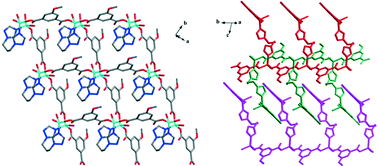Five Zn(II) coordination polymers, [Zn(mip)(btb)]·2H2O (1), [Zn2(mip)2(btb)1.5] (2), [Zn(moip)(btp)]·H2O (3), α-[Zn2(moip)2(btp)(H2O)2]·2H2O (4), β-[Zn2(moip)2(btp)(H2O)2]·2H2O (5), (H2mip = 5-methylisophthalic acid, H2moip = 5-methoxylisophthalic acid, btb = 1,4-bis(1,2,4-triazol-1-yl)butane, btp = 1,3-bis(1,2,4-triazol-1-yl)propane), have been obtained under hydrothermal conditions at 120 or 140 °C, respectively. Complexes 1 and 3 possess 3D supramolecular structures containing 1D tube-like chains. Complex 2 exhibits a (3,4,4)-connected trinodal 3D net with an unusual (6·82)(6·84·10)(6·85) topology. Complexes 4 and 5 are synthesized under similar conditions except for the pH values. Isomer 4 shows a 3D supramolecular network with a (82·10) topology. Isomer 5 features an extended 3D polythreaded network based on 2D bilayers, similar to that of 4. The construction of these complexes show that the temperature and pH value can modulate the resulting dimensionality and topology of the frameworks. Furthermore, the photoluminescence of complexes 1–5 has been investigated.

